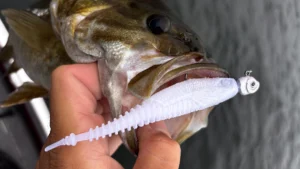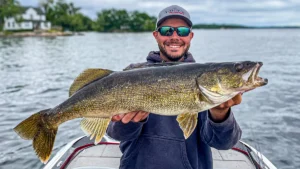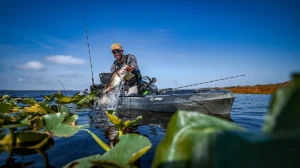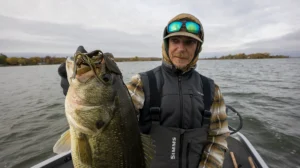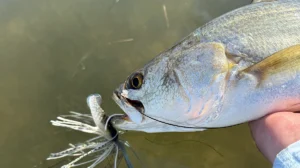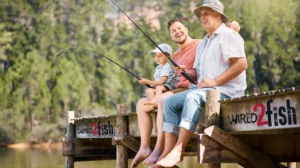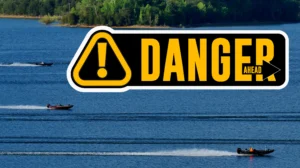This content-rich video is an excellent watch if you’re looking to get started with punching grass or advance your existing skillset. Like Seth Feider, Bassmaster Elite Series pro Bob Downey learned to bass fish on heavily vegetated lakes that required weedless presentations. Downey takes us on an ultra-thorough punching tutorial with topics ranging from finding mats and fishing them effectively to top tackle and rod setup recommendations.
TACKLE USED & BOAT CONTROL
- HOOK – VMC Ike Approved Heavy Duty Flippin Hook, 4/0
- WEIGHT – VMC Tungsten Flippin Weight, 3/4 or 1-ounce
- PEG – VMC Sinker Stops, Large
- ROD – St.Croix Legend Elite Series Casting Rod (Replaces Avid Series), 7’6″ MedHvy ModFast
- REEL – Daiwa Tatula Elite Flip/Pitch Casting Reel, 8.1:1
- LINE – Sufix 131 G-Core Braided Line, 50-pound
- SOFT PLASTIC BAIT – Reaction Innovations Spicy Beaver
Downey’s 6 Tips to Grass Punching Success:
- Locate grass mats fast. Grass mats develop where free-floating grass collects against hard stem cover such as lily pads, cattails, bullrushes, and cane. Consider prevailing winds — the densest mats will be located on the windward side of the lake.
- Quickly identify high-percentage areas in mats. Reading mats is like breaking down grasslines, with points, inside turns, bottom composition, and depth changes all bass concentrators (areas of change). Bass favor the heavy shade and open water beneath mats, but additional elements like shade lines, grass edges, and deeper pockets congregate fish. Run a pattern to add efficiency to your fishing day once you determine bass positioning in mats. Here’s an additional tip — focus your efforts on smaller mats over large expansive ones when time is limited. A smaller mat concentrates fish in a smaller area and fewer pitches to get the bite!
- Stay in direct contact with your line and bait throughout a pitch cast. Direct contact is essential for bite detection, quick hook sets, and determining the bottom composition and depth change. To build on this, Downey recommends learning to pitch with the same hand you reel with for the simple fact that it reduces wasted time and energy while enhancing contact with the bait. Regardless of what hand you pitch with, keep your index finger in touch with the line to detect bites you otherwise wouldn’t.
- Keep quiet and listen to your surroundings. Just because the bass are tucked into heavy cover doesn’t mean they’re not spooky. Shallow water bass don’t like a trolling motor and boat noise overhead. Downey advises getting off the troll and using your shallow water anchors when you come into a productive area. Nature often comes alive after sitting quietly for a minute or two. Listen for feeding fish such as the “kiss” of bluegills underneath pads or busting baitfish. If you see and hear life, you’re in the bass zone.
- Pair your tackle and rod setup to the cover. The weight leads the charge here. Downey selects a tungsten flipping weight that punches through the cover at least 90% of the time. If he can get away with it, 3/4-ounce tungsten is preferred; increase weight if it’s needed to punch the mat. A 4/0 heavy-duty flipping hook is king when it comes to hook, but he’ll increase to a 5/0 or scale back to a 3/0 depending on the size of his soft plastic. And forget the pool cue when it comes to a rod. A medium-heavy, moderate-fast taper casting rod in the 7’6” range has plenty of power for controlling bass but with some give to keep them buttoned.
- Adjust your retrieve cadence to the mood of the fish. So how long should you work a bait after pitching? Downey is a hop, hop, move guy. Most bites come on the initial fall or first hop or two. You have a lot of water to cover and fishing vertically — you need to keep moving to get your bait in front of bass. That said, you may want to slow your cadence when fishing high-percentage areas after a cold front.
OTHER GEAR
- SHALLOW WATER ANCHOR – Minn Kota Talon, 8ft Black
- TROLLING MOTOR – Minn Kota Ultrex 112/US2 Trolling Motor w/i-Pilot Bluetooth – 36V-112lb
- SUNGLASSES – Costa Del Mar Corbina
- HAT – Rapala Trucker Cap Center Logo




